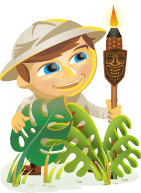 Want more people to watch, share, and comment on your live videos?
Want more people to watch, share, and comment on your live videos?
Looking for tips on improving the quality of viewer engagement?
To explore how to get more engagement with Facebook Live video, I interview Stephanie Liu.
More About This Show
The Social Media Marketing podcast is designed to help busy marketers, business owners, and creators discover what works with social media marketing.
In this episode, I interview Stephanie Liu, a live video expert and social media consultant. She hosts a Facebook Live show called Lights, Camera, Live, which is focused on helping businesses succeed with live video.
Stephanie explains how to promote your Facebook Live video with events and crossposting.
You'll also discover how questions, requests to share, and bots can improve Facebook Live video engagement.
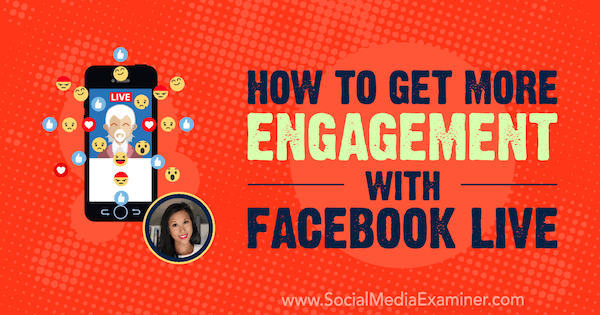
Share your feedback, read the show notes, and get the links mentioned in this episode below.
Listen Now
Where to subscribe: Apple Podcasts | Spotify | YouTube Music | YouTube | Amazon Music | RSS
Here are some of the things you'll discover in this show:
Engagement With Facebook Live
Stephanie's Story
Stephanie is an ad agency veteran. After working in the ad agency world for about 15 years, she decided to start her own business focused on a social media strategy. In a crowded field, Stephanie decided the best way to stand out was to do live video. She wanted to be an early adopter to separate herself from the pack.
About 2 years ago, when Periscope was a big deal and Facebook Live was just rolling out for the masses, Stephanie started going live with OBS Studio, and Facebook Live provided the most client referrals.
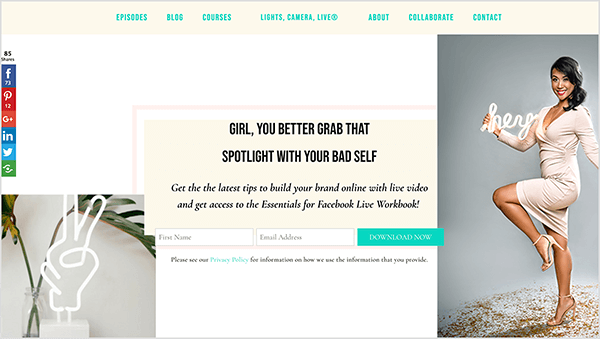
Get World-Class Marketing Training — All Year Long!
Are you facing doubt, uncertainty, or overwhelm? The Social Media Marketing Society can help.
Each month, you’ll receive training from trusted marketing experts, covering everything from AI to organic social marketing. When you join, you’ll also get immediate access to:
- A library of 100+ marketing trainings
- A community of like-minded marketers
- Monthly online community meetups
- Relevant news and trends updates
In a collaboration with Chef Claudia Sandoval, the winner of MasterChef Season 6, Stephanie had one of her early successes with live video marketing. Claudia was working with T-Mobile and MasterChef on a Facebook Live promotion for the new T-Mobile Tuesdays app. Claudia noticed Stephanie's efforts to break into live video and asked for Stephanie's help figuring out how to do it.
Stephanie planned a low-tech live video with Claudia using a regular iPhone 6 and one ring light. They created plans to generate buzz before the live event, keep people engaged during the broadcast, and keep the app top of mind and tip of tongue after the live broadcast.
During the live stream, Claudia made her famous Tres Leches Cake recipe. The broadcast lasted about an hour and a half. The whole time, someone held the iPhone by hand. They didn't have a tripod because Claudia was moving around the kitchen, and this was before anyone was using a live gimbal.
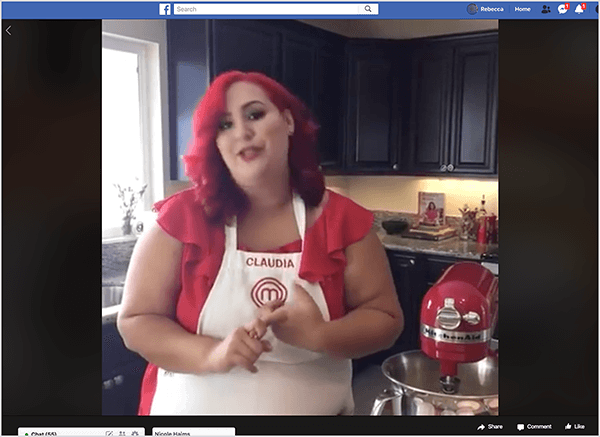
The results of the promotion were amazing. As soon as Claudia went live, the video had 843 peak live viewers. Right after the broadcast, 1.5 million people opened the T-Mobile Tuesdays app, and Claudia's cookbook had 178,000 downloads.
Since then, Stephanie has continued to help clients build their brands and bottom lines with live video. Whether a client is launching their own Facebook Live show or incorporating live video into their events, Stephanie helps make their live video marketing a success.
Listen to the show to hear Stephanie talk about her friendship with Claudia.
Why Focus on Facebook Live?
Stephanie thinks marketers who want to hit the ground running with Facebook should focus on Facebook Live because it has 10 times more reach than all other types of Facebook content. Since Facebook changed its algorithm in January 2018, organic reach has been dwindling to nothing.
Facebook Live video also has six times more interactions than recorded video. These interactions keep your brand top of mind and tip of tongue, and are a way to attract the meaningful engagement that Facebook wants. I note that the results Stephanie has seen with reach and engagement reflect what Social Media Examiner experiences, going live multiple times per week.
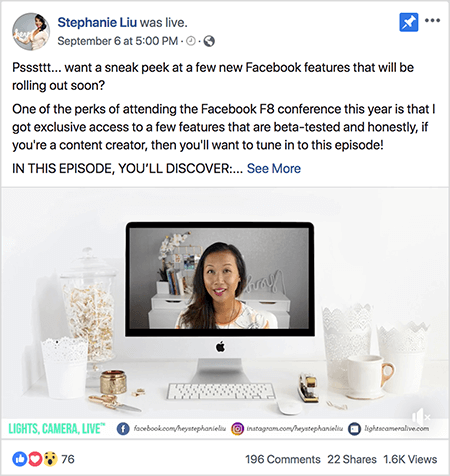
Stephanie has also learned that a new product, Facebook Live Producer, will make going live much easier. At the Facebook F8 conference in May 2018, Stephanie talked to someone who works on Facebook Live and learned that Facebook will be putting out this new product.
Facebook Live Producer does all of the things third-party tools (like OBS Studio, Ecamm, or BeLive) do and more. For instance, Facebook Live Producer allows you to bring on a guest, set up split screens, and add text overlays. The tool is built into the web browser and puts other platforms on notice. Generally speaking, Facebook's tools are easier to use than third-party tools.
Listen to the show to hear my thoughts about leaked screenshots I saw of Facebook Live Producer about a year ago.
How to Generate Buzz Before a Live Video
Stephanie treats any live-streaming video like an actual event, which means she invests effort into promoting the live video beforehand. Although anyone who follows your page receives a notification when you go live, that notification isn't enough to reap the full benefits of your live video. Your page followers might be standing in line at the grocery store or stuck in traffic, so they can't tune in.
Facebook Event: To get engagement as soon as you go live, get people to talk about your live video for about a week beforehand. To do that, Stephanie starts by creating a Facebook event for the live video with a detailed description. She explains why people want to tune in, what she'll talk about, what the live video will show viewers how to do, and what will happen if they don't tune in.
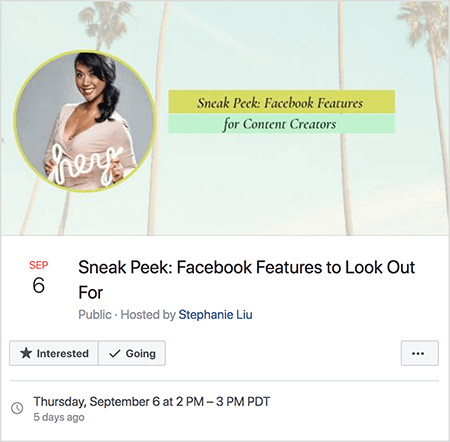
If Stephanie's live video will feature a guest, she invites them as a co-host. This way, they can both invite people from their networks and collaborate on getting people talking about the event a week in advance. You can ask people to share questions they'd like to ask the guest in the event comments, which is a great way to engage people interested in the guest or topic.
Stephanie occasionally spends a small amount to promote the event, but most of the time, she doesn't put a lot of money behind the actual Facebook event.
Scheduled Live Broadcast Link: It's important to note that Stephanie doesn't go live within the Facebook event. She goes live from her page, so everyone who follows her page receives a notification when she's live. In the event, she shares a link to a scheduled live broadcast. With this permalink, Stephanie can share a link to a live video in an email, social media copy, and the Facebook event.
Typically, Stephanie creates the event 1 week before the live stream. The day before the Facebook Live, she leaves a comment reminding people of the live video and asking for last-minute questions. About an hour before the broadcast, she leaves another reminder in the event and shares the permalink. Every time she posts in the event, everyone who has RSVP'd receives a notification.

This build-up to the event increases the likelihood people will watch live. Even if they can't make the live video, they'll ask Stephanie about the replay. That's another opportunity for her to engage with her audience and share the link to her live video. After the live video, she can also continue posting in the event. For example, she might share a link to a blog post that recaps the video.
When Stephanie posts the link to the scheduled live broadcast, she also adds a comment on the post. You want to be the first person to leave a comment because that tells people who want to engage with you how to do so. Stephanie typically leaves a comment that says, “If you're tuning in, let me know where you're watching from.” This icebreaker helps people in similar locations connect.
Any conversations within the event and on your link post help your live video. As an illustration, a conversation about where people are from can turn into a conversation about conferences or events people are attending. As one question leads to another, a sense of community can develop around the topic of your live video.
Email: Outside of Facebook, Stephanie promotes the live video in emails. In the email, she shares a link to the Facebook event because that's where people see social proof. If people see that an event has a certain number of RSVPs, they won't want to miss out. They'll want to be part of the live event.
If Stephanie is inviting a guest, she also creates suggested promotional copy the guest can use across their social media or email.
Messenger Bot: Stephanie uses her messenger bot, RoboSteph, to promote live videos, too. She tells her current subscribers when a live video is coming up and they can click RSVP in the bot. RoboSteph can also share a message like, “Hey, we're live now. Click here to tune into our new episode.”
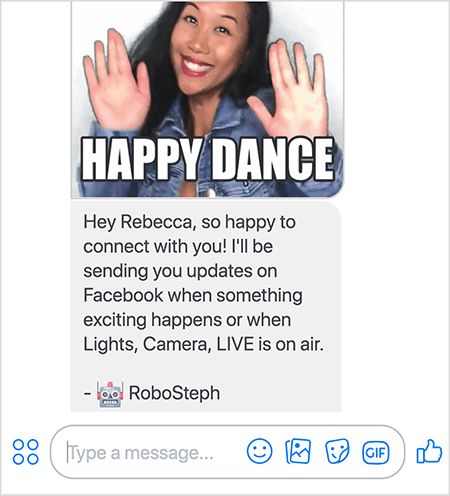
To get bot subscribers, Stephanie asks people who want a reminder for the live video to leave the comment “subscribe” on the Facebook post that links to the scheduled live broadcast. When someone subscribes, RoboSteph confirms their subscription, thanks the person for their RSVP, and then confirms it will send a reminder for the live video.
Stephanie set up her bot using ManyChat and the Facebook Comments Growth Tool. With this tool, the bot knows to message subscribers as soon as she goes live. The automated reminder helps bring live viewers on-air so she's not talking to an empty audience.
Listen to the show to hear my thoughts on the similarities between Facebook groups and events.
Live Crossposting
Crossposting means asking other people or pages to promote your content for you. The ability to do live crossposting with a blitz marketing campaign became available earlier this year. With this feature, you can partner with other pages so a live video on your page appears on all of your partner pages, too.
For instance, if you have a flash sale or a limited-time offer that's about to expire, you could use live crossposting to have a blitz campaign that alerts people to your timely offer.
To set up crossposting, open the Settings for your Facebook page. In the left-hand sidebar, click the Crossposting option. Then you'll see a screen where you can type the name of another page so it's linked to yours.

Discover Proven Marketing Strategies and Tips
Want to go even deeper with your marketing? Check out the Social Media Marketing Podcast! Publishing weekly since 2012, the Social Media Marketing Podcast helps you navigate the constantly changing marketing jungle, with expert interviews from marketing pros.
But don’t let the name fool you. This show is about a lot more than just social media marketing. With over 600 episodes and millions of downloads each year, this show has been a trusted source for marketers for well over a decade.
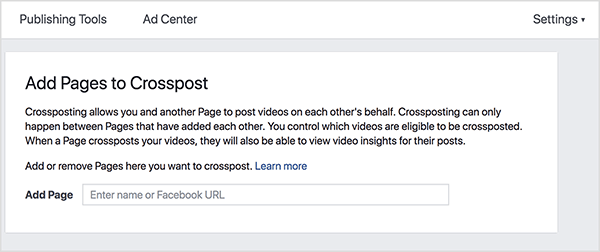
After you set up crossposting, the page connected to yours can control whether its followers see your live stream. The other page can control this manually, schedule a time to share your content, or share your live videos automatically. Crossposting can work for regular recorded videos as well.
Listen to the show to hear Stephanie and me discuss when live video appears as a crosspost.
Tips for Getting Live Viewer Engagement
To encourage engagement during a live video, Stephanie combines several tactics, including welcoming viewers, asking for shares, and encouraging meaningful comments.
Welcoming Viewers: Stephanie begins her live videos by briefly welcoming viewers. Everyone loves the sound of their own name and will tune in a little bit longer because they notice they can interact with you in real time. However, you need to balance these welcomes with details about the video's content.
You can start the video with basic information about the video, when very few people have joined the live stream. Explain why the topic matters, what you're going to cover, and what they'll learn how to do.
To illustrate, Stephanie starts a show by saying, “Hey everyone. Today we're going to talk about Facebook Live and why it's important for your business, and what it can do for you. I'm going to show you how to bring comments onto the show, and if you don't have time right now to tune in, that's okay. Leave the comment ‘subscribe' and I'll notify you when the replay is done.”
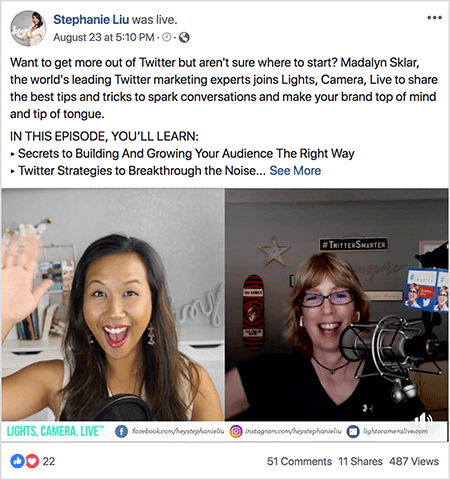
Stephanie might then briefly greet someone by saying, “Hey, Mike, thanks so much for joining. Nice to see you again.” In other words, don't spend the first 2 minutes greeting every person.
Stephanie also likes asking people where they're from as an easy icebreaker. She usually tells viewers she's broadcasting live from San Diego and asks where they're tuning in from. If someone says, “Hey, I'm tuning in from Guam,” Stephanie might respond, “Wow, I've never had someone tune in from Guam. This is awesome. Welcome to the show.”
Because people often don't join a live video as soon as it begins, Stephanie repeats her introduction to the show about 10-15 minutes into the live video.
Tags and Shares: To spread the word about her video, Stephanie asks viewers to tag friends in the comments and share her live video. She might say, “If you know anyone who will be interested in this episode, do them a favor. Tag them in the comments. Share this to your personal profile or your groups.” She finds most people will share the video because it's an easy, one-click action.
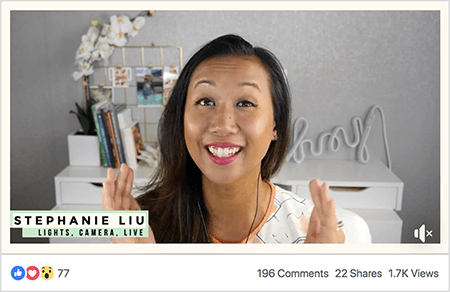
Each time Stephanie repeats her introduction to her live video topic, she includes her request to tag a friend, share the video, or subscribe to her bot for details about the replay. She repeats these details in the middle of her show and at the very end.
You can also encourage people to share by having a share sponsor. Stephanie learned this idea from Owen Hemsath of Owen Video. He gives away a 10-second spot at the beginning of his next show, and to enter, viewers have to share the video. The opportunity for free publicity is popular among his viewers.
Groups: I ask for Stephanie's thoughts on sharing a live video in Facebook groups. She says the video should be relevant and offer value to the group. For example, a video about social media can help people in her Social Media Strategist group. You also need to adhere to any group rules about promotion within the group.
If you own a group, you can organize a Facebook watch party for your live stream in your group. A watch party is like a playlist that's available to the group. A post introducing the watch party says something like, “We're going to have a watch party on XYZ subject.” Group members can watch the playlist whenever they like, and comments on specific videos appear in the group.
On-Screen Comments: Just as people like to hear you welcome them by name, they like seeing their comments on-screen. When you show people's comments with tools like BeLive or Ecamm, people are super-excited to engage with you.
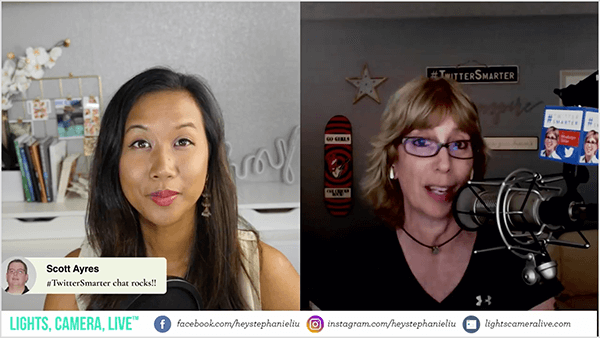
Meaningful Comments: Because Stephanie usually has a guest on her show, she'll elicit meaningful comments by reminding viewers that the live video is an easy time to get one-on-one advice from the guest. Then she asks viewers to ask questions in the comments. If you don't have a guest, you can ask viewers to leave their questions for you instead.
Listen to the show to hear my thoughts on asking viewers to share a live video and tag friends in the comments.
How to Follow Up After a Live Video
After a live video is over, Stephanie follows up by encouraging ongoing comments and conversations. For Lights, Camera, Live, she goes live about twice per month, and viewers tend to make three comments. The first is where they're from; the second is something like, “I didn't know that;” and the third is a request for more information about a topic.
After the broadcast ends, Stephanie answers requests for more information because she wants to nurture relationships with engaged viewers. The next day, Stephanie responds to comments from people who watched the replay. She not only thanks the commenter for watching, but also asks an open-ended question such as, “What did you think about the last episode?”
When Stephanie responds to comments in this way, people keep engaging with her, and this engagement makes her live video reappear in the news feed. The more viewers leave a comment on, like, or share your live video, the more visibility the live stream has in the news feed.
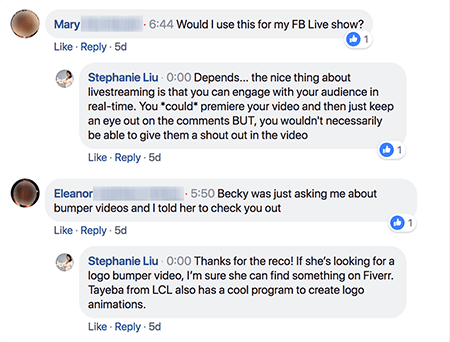
Stephanie also uses comments after a live video to gather topic ideas from her audience. She asks what viewers want to learn because that helps her create content that interests them.
Comments on a previous live video or event can promote an upcoming one. One of Stephanie's most successful Facebook Live interviews was with Jenn Herman, an Instagram marketing expert. Because the Instagram algorithm is always changing or myths need to be debunked, Stephanie can leave a comment on the old interview such as, “If this video interested you, here's the next episode.”
On a video like the Jenn Herman interview, Stephanie's comment helps her audience know changes are coming, so the comment adds value and promotes the upcoming event. Because they'll know the upcoming video can help them, Stephanie is nurturing her relationship with these viewers using all of the organic ways Facebook offers.
To manage all of this work, Stephanie uses Asana to keep a checklist for her team. Also, for her business, she needs to go live only twice a month. Because she delivers valuable content, she gets a new client referral every time she's done going live.
Listen to the show to hear how updates to my old live videos and posts led to continued engagement in the comments.
Discovery of the Week
When your social media image posts are stuck in a rut, PostMuse can kickstart your creativity.
Like many image editing apps for Instagram, PostMuse includes tips and tricks, photo filters, different fonts, and other tools. What sets PostMuse apart is the ability to draw inspiration from pre-made templates. For instance, you can see different ways to use overlays, filters, and so on for a single stock image. From there, you can substitute your own image and create something unique.
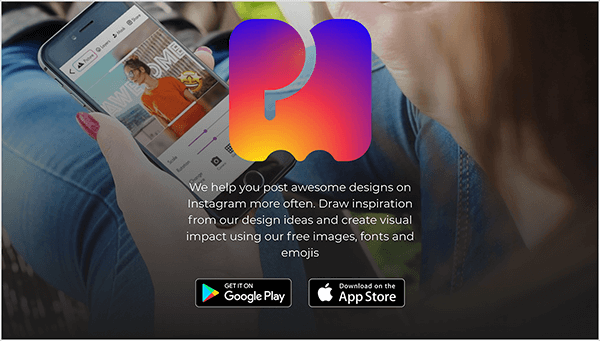
Although PostMuse templates show an affinity for Instagram-like posts, the app isn't specifically for Instagram. You can export images you edit in the app and post them anywhere you like. Also, you can create vertical images for stories.
PostMuse is a quick and easy app that's a great addition to your tool belt. The app is free and available for iPhone and for Android.
Listen to the show to learn more and let us know how PostMuse works for you.
Key takeaways from this episode:
- Find Facebook Live updates, freebies, and more on Stephanie's website.
- Follow Stephanie on Facebook and watch her live show, Lights, Camera, Live.
- Join Stephanie's Facebook group, Social Media Strategist.
- Learn more about live-streaming software OBS Studio, Ecamm, and BeLive.
- Watch Stephanie's live video collaboration with Claudia Sandoval.
- Hear Stephanie discuss Facebook Live Producer in a recent live video.
- Check out the recap of the Facebook F8 conference in May 2018.
- Learn how to schedule a live broadcast.
- Set up a Messenger bot with ManyChat and the Facebook Comments Growth Tool.
- Learn more about Owen Hemsath of Owen Video.
- Find creative inspiration and edit images in PostMuse.
- Watch our weekly Social Media Marketing Talk Show on Fridays at 10 AM Pacific on Crowdcast or tune in on Facebook Live.
- Download the 2018 Social Media Marketing Industry Report.
- Learn about Social Media Marketing World 2019.
Help Us Spread the Word! Please let your Twitter followers know about this podcast. Simply click here now to post a tweet.
If you enjoyed this episode of the Social Media Marketing podcast, please head over to iTunes, leave a rating, write a review, and subscribe. And if you listen on Stitcher, please click here to rate and review this show.
What do you think? What are your thoughts on getting engagement with Facebook Live video? Please share your comments below.
Attention Agency Owners, Brand Marketers, and Consultants

Introducing the Marketing Agency Show–our newest podcast designed to explore the struggles of agency marketers.
Join show host and agency owner, Brooke Sellas, as she interviews agency marketers and digs deep into their biggest challenges. Explore topics like navigating rough economic times, leveraging AI, service diversification, client acquisition, and much more.
Just pull up your favorite podcast app, search for Marketing Agency Show and start listening. Or click the button below for more information.

